Best Right Angle Drills — Buyers Guide, Top Picks, and Comparison
Allowing you to access the most restricted of spaces — right angle drills are the close-quarter drilling virtuosos. Distinguishable by their slimline build, snub-head, one-handed operation capability, and large paddle throttles — these versatile machines are ideal for DIYers and trade-pros whose work involves awkward location drilling and driving. Whether you’re attacking sub-floor joists, removing screws inside engine bays, or drilling beneath sinks — there’s a cordless, corded, or pneumatic machine to make your work effortless.
Right Angle Drill Categories
Right Angle Drill Information
Right Angle Drill Categories
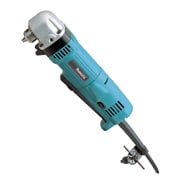
Corded Right Angle Drill
An electric right-angle drill opens up a whole new world of drilling possibilities. Its compact build combined with a 90-degree snub head provides effortless access to confined spaces, such as inside cupboards, under sinks, and between floor joists. Mains-powered, it offers consistent and brawny power — and typically boasting either one or two-handed operation, you can adjust your driving style to suit your project’s demands.
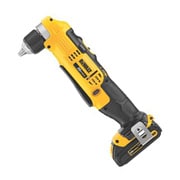
Cordless Right Angle Drill
A cordless right angle drill is the ultimate challenging-space, boring, and driving tool. With a 90-degree head, compact design, one-handed operation capabilities, and driven by a lithium-ion cell — it allows you to work in seriously confined areas without requiring mains electric access. Offering lengthy running times, impressive speed, and a large trigger paddle — it’s the effortless solution to working in lofts, beneath floorboards, and between joists.
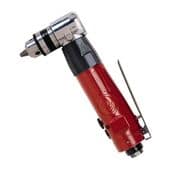
Air Powered Right Angle Drill
A right angle air powered drill offers the ultimate in speed, strength, and confined-space utility. Driven by a compressor, these tools offer more immense grunt than their electric counterparts — and can be combined with additional accessories such as brushes, cutters, and polishers. Substantial rear or front-mounted throttle paddles stave off finger fatigue — while their lightweight aluminum build elevates operational stamina. Easy-on-the-wallet — although requiring the ownership of a pneumatic power unit — they’re ideal for sheet metal, dense timber, and automotive work.
Right Angle Drill Top Picks In Each Category
| IMAGE | PRODUCT | DETAILS | ||
|---|---|---|---|---|
|
Best Cordless Right Angle Drill 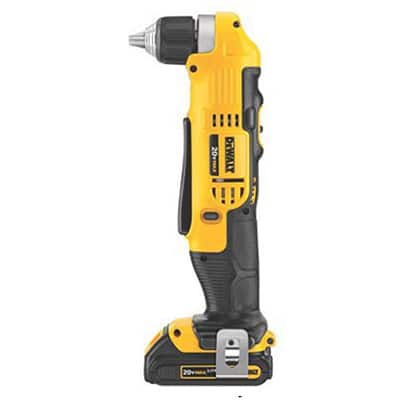
|
Best Cordless Right Angle Drill
|
DeWalt DCD740C1
|
Features
|
Check Price at Amazon DeWalt DCD740C1 Review DeWalt DCD740C1 Review |
|
Best Electric Corded Right Angle Drill 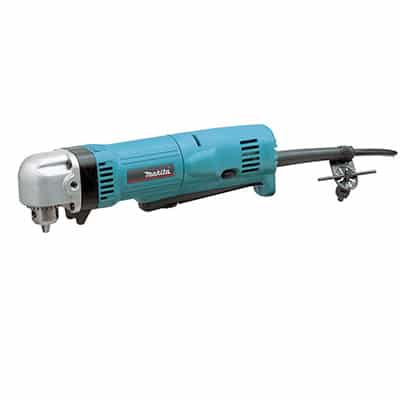
|
Best Electric Corded Right Angle Drill
|
Makita DA3010F
|
Features
|
Check Price at Amazon Makita DA3010F Review Makita DA3010F Review |
|
Best Air Powered Right Angle Drill 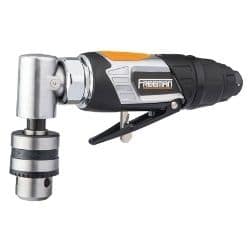
|
Best Air Powered Right Angle Drill
|
Freeman FAT38AD
|
Features
|
Check Price at Amazon Freeman FAT38AD Review Freeman FAT38AD Review |
Finding the Best Right Angle Drills – Buyer’s Guide
Compact, lightweight, and designed to reach into the most inaccessible of areas — right angle drills are an invaluable weapon in the ardent DIYers and trade-pros driving arsenal.
Affordable, effortless to operate, and available in corded, cordless, and air-powered formats — these versatile units are ideal for cabinet building, home renovation, and automotive repair and restoration.
What Is a Right Angled Drill?
Also known as 90 degree right angle drill units and close-quarter drills — these flexible machines are the masters of restricted space drilling.
Built to function in the most awkward of environments, they’re typified by:
90-Degree Chuck
The key feature that gives the right angle drill its moniker.
Instead of the chuck being in line with the drill body — as with standard drills, true die grinders, and Dremels — the right angle driver features the head at 90 degrees to the body/handle.
This permits you to steer the tool into tight areas — as small as just two inches — which would be impossible to achieve with a typical drill/driver.
Snub Head
A scaled-down head reduces operational space requirements — allowing for serious close-quarter drilling.
That being said, the majority of 90-degree chucks still boast the industry standard of 0.375-inches. Furthermore, you can also purchase half inch right angle drill machines, capable of utilizing large diameter bits, such as the DeWalt DWD460.
Slimline Body
The best right angle drill units feature a slimline body — held in a similar manner as you would grasp a torch. Expert engineering has enabled these machines to have their internal motors (in the case of electric models) completely sealed within the handle — and then, through a system of cogs, turn the vertical rotation into horizontal.
This minimalist construction again allows the drill to be maneuvered into low-space environments.
Lightweight
The majority of 90-degree compact angle drill tools are remarkably lightweight — typically weighing in at 2-2.5 pounds.
Since many close-quarter applications will necessitate one-handed operation, this lack of heft means they’re less likely to induce fatigue on lengthy projects.
Paddle Throttle
Unlike standard drills, which feature a single or dual finger trigger — low profile right angle drill machines are identifiable by their large, elongated throttle paddles.
Not only does this keep the width of the tool to a minimum — with no protruding trigger — it also allows for effortless depression. Typically sufficiently large to accommodate four digits — it permits you to operate and adjust the rotation speed however confined the space.
Applications for 90-Degree Drills
Despite the right-angle drills being designed for confined space work — due to their slimline and compact design, many DIYer and homeowners opt for these tools as their main home drill.
Admittedly, they lack the grunt for masonry and brickwork projects — for that you’ll need a standard corded or cordless unit. However, they’re excellent for addressing timber, MDF, chipboard, and light metal work around your house.
But, the right-angle drill remains the mother-of-all close-quarter boring machines. As such, it’s particularly suited to:
Different Types of Right Angle Drills
In the 90-degree drilling category, there are three types of right-angled machines — corded, cordless, and air-powered.
Right Angle Corded Drills
The corded 90-degree niche features the greatest diversity of machines — from seriously compact mini right angle drill units through to heavy-duty tools such as the DeWalt DWD460.
Being driven via a mains cord — they have the advantage of consistent power, and typically exhibit more torque and higher speeds than their cordless counterparts.
However, this can impact operational freedom.
Not only do you require access to an electrical point, but you’re also restricted by the length of the unit’s cord — typically no longer than eight feet. This means in most situations, an extension cable will be necessary.
The corded format is the most affordable in the right angle drill category — making them ideal for those on a budget or newbies to confined space driving. Admittedly, gun-only pneumatic machines are cheaper, but they necessitate a separately purchased compressor to function.
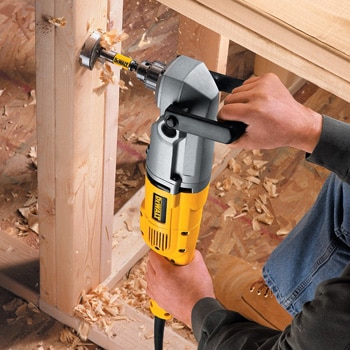
Pros of Right Angle Corded Drills
- No compressor or battery recharge concerns.
- Stable power output.
- More brawn than cell-driven models.
- Affordable.
- Large range from small right angle drill to large industrial 90-degree units.
Pros of Right Angle Corded Drills
- Require access to a power outlet.
- Lengthy mains cable and extension cords can be hazardous.
- Despite being brawny — lack the massive torque of pneumatic units.
Right Angle Cordless Drills
Incomparably portable, these battery-powered machines offer the highest level of operational freedom in the entire 90-degree category. With charges permitting up to 45 minutes of operation — depending on torque demands — they deliver pleasing running times to complete the majority of projects.
Admittedly, they lag slightly behind the corded models in terms of power. Although over the last five years, modern lithium-cell technology has reduced this differential significantly.
If you opt for a cordless unit — always check whether it comes complete with a charger and cell pack. With many models arriving as tool-only, it can be annoying if you don’t already own a compatible battery or charger.
Furthermore, bear in mind that due to the power unit being attached to the tool itself, they are significantly heavier than their mains-driven counterparts — and with a lower center of gravity.
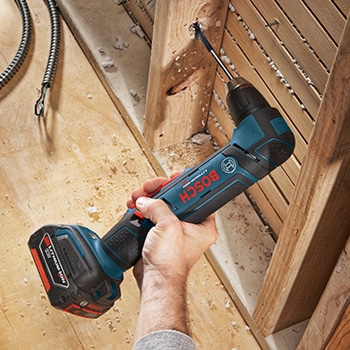
Pros of Right Angle Cordless Drills
- Pleasingly portable.
- Eliminate the annoyance and hazards of mains cables.
- Impressively long running times.
- More suited to high-level work than corded models.
Cons of Right Angle Cordless Drills
- Harder on the pocket than the mains-driven format.
- Restricted running times — unless you purchase additional cells.
- Carry more heft than their corded cousins.
Right Angle Air-Powered Drills
Offering higher speeds and more intense torque than their cordless and corded siblings, these industrial-grade machines are the go-to units for automotive restorers and sheet metal and acrylic workers.
Compatible with a vast array of die grinder accessories — such as points, cutters, brushes, flat wheels, and burrs — they offer finishing, honing, and polishing possibilities in addition to their drilling and driving capabilities.
However, requiring an additional pneumatic power unit, initial costs can be significant. Furthermore, the compressor requirement means that these tools are louder than all other right-angle drills — and the least portable.
That said, with few internal components, there is little to malfunction. And being seriously brawny, there are few materials an air-powered drill can’t handle — although, they’re serious overkill for most indoor timber projects.
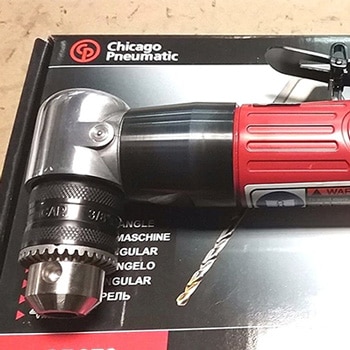
Pros of Right Angle Air Powered Drills
- Ultimate in grunt and rapidity.
- Ideal for automotive and dense material work.
- Compatible with a multitude of accessories.
- Straightforward to operate.
- Easy maintenance.
Cons of Right Angle Air Powered Drills
- Require an air compressor.
- Not portable.
- Noisy.
- Overkill for most DIY home projects.
Considerations When Purchasing Right Angle Drills
The cordless, corded, or pneumatic drill categories all have their own specific nuances that you need to consider when selecting your ideal machine. For these distinct types — I recommend you check out my three guides to mains-driven, battery-powered, and air-powered units.
However, as a general outline, here are the main factors you should examine when looking at right-angle drills.
Format
As outlined earlier, there are three types of 90-degree drills — cordless, corded, and pneumatic.
Consider what type of projects and in what context you will use your right-angle tool to ensure you select the perfect format.
For hardcore, garage-based work, opt for an air-driven model. Where your jobs demand consistent power, go for a corded machine. And, when you require the ultimate in portability and close-quarter access of a drill for tight spaces — select a battery-powered model.
Chuck
The 0.375-inch will be suitable for most DIY applications — able to accommodate the majority of wood and metal bits. The 0.5-inch chuck allows you to utilize wide-diameter boring heads — useful if you’re creating channeling for pipes or wiring looms.
Furthermore, check whether the chuck is keyed or keyless. The keyed format permits greater bit stability — crucial if you’re attacking dense materials. Keyless chucks remove the headaches of lost keys — reducing annoyances and downtime.
Torque and Speed
The same applies in drills, they either deliver high torque or rapidity, depending on the internal gearing. Hence, when looking at 90-degree machines — consider which of these two specifications is of most importance.
For time-intensive, repetitive screwdriving, a high-speed unit may be beneficial. If your projects mainly include boring into dense hardwoods or metals — go for a high torque drill.
Secondary Handle
Admittedly, they reduce the confined-space utility of the unit by increasing its width — but being detachable, you can restore your machine to its original slimline design when required.
Additional Accessories
Depending on the tool format, look out for:
- Carry case or pouch.
- Secondary handle.
- Depth gauge.
- Gear oil.
- Replacement gaskets.
- Power cell.
- Battery charger.
- Warranty length.
Conclusion
With a range including corded, cordless, and pneumatic machines — there’s a close-quarter drill ideal for users who demand consistent power, the ultimate in portability, or massive grunt and torque.
Able to access the tightest of spaces — right-angle drills with their snub head, large trigger throttles, and one-handed operation increase productivity, reduce downtime, and avoid the headaches of knocked knuckles.
So instead of trying to squeeze your hefty SDS unit beneath a sink, between joists, or under decking — instead get one of the best right angle drills.
Right-Angle 90-Degree Drill FAQs
Q: What Is the Best Right Angle Drill?
This depends on your project requirements. I’d suggest for consistent power, check out the Makita DA3010F, for cordless operation, the DeWalt DCD740C1, and for the ultimate in pneumatic brawn, the Freeman FAT38AD.
Q: What Is a Right Angle Drill Attachment?
A right-angle drill attachment allows you to convert a standard inline drill to work at 90-degrees. While this may assist for awkward-angle drilling — it makes the drill unable to access confined spaces — one of the key features of a true right-angle machine.
Q: Who Uses Right Angle Drills?
With their ability for close-quarter operation, right-angle 90-degree drills are favored by:
- DIYers.
- Automotive restorers.
- Home improvers.
- Carpenters.
- Plumbers.
- Attic and basement convertors.
- Mechanics.
- Joiners.
- Cabinet makers.
Q: Why Use a Right Angled Drill?
The slimline design, 90-degree snub head, and large paddle throttle allow DIYers and trade contractors to drill and drive in areas inaccessible by standard inline machines.
Q: Are Right Angled 90 Degree Drills Difficult to Use?
No. In fact, due to their lightweight, incorporated four-digit throttle, and slimline design — they require less effort to wield than a standard corded drill.
Q: What’s the Difference Between an Air Powered Right Angle Drill and a Die Grinder?
A die grinder — or the electrical equivalent, such as a Dremel — features the chuck inline with the machine body. Conversely, a pneumatic right angle drill has a chuck head at 90 degrees to the unit’s casing. However, like a die grinder, an airless right-angle machine can also accommodate brushes, points, burrs, and cutters.
